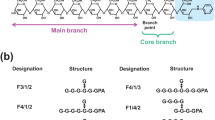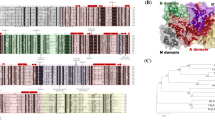Abstract
This review describes a new enzymatic method for in vitro glycogen synthesis and its structure and properties. In this method, short-chain amylose is used as the substrate for branching enzymes (BE, EC 2.4.1.18). Although a kidney bean BE and Bacillus cereus BE could not synthesize high-molecular weight glucan, BEs from 6 other bacterial sources produced enzymatically synthesized glycogen (ESG). The BE from Aquifex aeolicus was the most suitable for the production of glycogen with a weight-average molecular weight (M w) of 3,000–30,000 k. The molecular weight of the ESG is controllable by changing the concentration of the substrate amylose. Furthermore, the addition of amylomaltase (AM, EC 2.4.1.25) significantly enhanced the efficiency of this process, and the yield of ESG reached approximately 65%. Typical preparations of ESG obtained by this method were subjected to structural analyses. The average chain length, interior chain length, and exterior chain length of the ESGs were 8.2–11.6, 2.0–3.3, and 4.2–7.6, respectively. Transmission electron microscopy and intrinsic viscosity measurement showed that the ESG molecules formed spherical particles. Unlike starch, the ESGs were barely degraded by pullulanase. Solutions of ESG were opalescent (milky-white and slightly bluish), and gave a reddishbrown color on the addition of iodine. These analyses revealed that ESG shares similar molecular shapes and solution properties with natural-source glycogen. Moreover, ESG had macrophage-stimulating activity and its activity depends on the molecular weight of ESG. We successfully achieved large scale production of ESG. ESG could lead to new industrial applications, such as in the food, chemical, and pharmaceutical fields.
Similar content being viewed by others
Abbreviations
- AM:
-
amylomaltase
- BE:
-
branching enzyme
- DP:
-
degree of polymerization
- ESG:
-
enzymatically synthesized glycogen
- GP:
-
α-glucan phosphorylase
- HPSEC-MALLS-RI:
-
high-performance size-exclusion chromatography with a multiangle laser light scattering photometer and a differential refractive index detector
- IAM:
-
isoamylase
- NSG:
-
natural-source glycogen
- SP:
-
sucrose phosphorylase
- TEM:
-
transmission electron microscopy
References
Boyer C. & Preiss J. 1977. Biosynthesis of bacterial glycogen: purification and properties of the Escherichia coli B α-1,4-glucan: α-1,4-glucan 6-glycosyltransferase. Biochemistry 16: 3693–3699.
Boyer C.D., Simpson E.K.G. & Damewood P.A. 1982. The possible relationship of starch and phytoglycogen in sweet corn. II. The role of branching enzyme I. Starch/Stärke 34: 81–85.
Cori G.T. & Cori C.F. 1943. Crystalline muscle phosphorylase. IV. Formation of glycogen. J. Biol. Chem. 151: 57–63.
Fujii K., Takata H., Yanase M., Terada Y., Ohdan K., Takaha T., Okada S. & Kuriki T. 2003. Bioengineering and application of novel glucose polymers. Biocatal. Biotransform. 21: 167–172.
Fukui T., Shimomura S. & Nakano K. 1982. Potato and rabbit muscle phosphorylases: comparative studies on the structure, function and regulation of regulatory and nonregulatory enzymes. Mol. Cell. Biochem. 42: 129–144.
Geddes R. 1986. Glycogen: a metabolic viewpoint. Biosci. Rep. 6: 415–428.
Hashimoto T., Kurose M., Oku K., Nishimoto T., Chaen H., Fukuda S. & Tsujisaka Y. 2006. Digestibility and suppressive effect on rats’ body fat accumulation of cyclic tetrasaccharide. J. Appl. Glycosci. 53: 233–239.
Hata K., Hata M., Hata M. & Matsuda K. 1983. The structures of shellfish glycogens I. J. Jpn. Soc. Starch Sci. 30: 88–94.
Hata K., Hata M., Hata M. & Matsuda K. 1984. A proposed model of glycogen particle. J. Jpn. Soc. Starch Sci. 31: 146–155.
Heath E.M., Morken N.W., Campbell K.A., Tkach D., Boyd E.A. & Strom D.A. 2001. Use of buccal cells collected in mouthwash as a source of DNA for clinical testing. Arch. Pathol. Lab. Med. 125: 127–133.
Kajiura H., Kakutani R., Akiyama T., Takata H. & Kuriki T. 2008. A novel enzymatic process for glycogen production. Biocatal. Biotransform. 26: 133–140.
Kajiura H., Takata H., Kuriki T. & Kitamura S. 2010. Structure and solution properties of enzymatically synthesized glycogen. Carbohydr. Res. 345: 817–824.
Kakutani R., Adachi Y., Kajiura H., Takata H., Kuriki T. & Ohno N. 2007. Relationship between structure and immunostimulating activity of enzymatically synthesized glycogen. Carbohydr Res. 342: 2371–2379.
Kakutani R., Adachi Y., Kajiura H., Takata H., Ohno N. & Kuriki T. 2008. Stimulation of macrophage by enzymatically synthesized glycogen: the relationship between structure and biological activity. Biocatal. Biotransform. 26: 152–160.
Kitahata S. 1995. Debranching enzymes (isoamylase, pullulanase), pp. 18–27. In: The Amylase Research Society of Japan (ed.), Enzyme Chemistry and Molecular Biology of Amylases and Related Enzymes, CRC Press, Boca Raton.
Kitahata S. & Okada S. 1988. Branching enzymes, pp. 143–154. In: The Amylase Research Society of Japan (ed.), Handbook of Amylase and Related Enzymes, Pergamon Press, Oxford.
Kitamura S. 1996. Starch polymers, natural and synthetic, pp. 7915–7922. In: Salamone J.C. (ed.), Polymeric Materials Encyclopedia, CRC Press, Boca Raton.
Kitamura S., Kobayashi K., Tanahashi H., Ozaki T. & Kuge T. 1989. On the Mark-Houwink-Sakurada equation for amylase in aqueous solvents. (Dilute solution properties of starch related polysaccharides. Part 1) Denpun Kagaku 36: 303–309.
Kjoelberg O., Manners D.J. & Wright A. 1963. α-1,4-Glucosans. XVII. The molecular structure of some glycogens. Comp. Biochem. Physiol. 34: 353–365.
Manners D.J. 1991. Recent developments in our understanding of glycogen structure. Carbohydr. Polym. 16: 37–82.
Mantovani B. 1981. Phagocytosis of immune complexes mediated by IgM and C3 receptors by macrophages from mice treated with glycogen. J Immunol. 126: 127–130.
Ohdan K., Fujii K., Yanase M., Takaha T. & Kuriki, T. 2006. Enzymatic synthesis of amylose. Biocatal. Biotransform. 24: 77–81.
Okada K., Yoneyama M., Mandai T., Aga H., Sakai S. & Ichikawa T. 1990. Digestion and fermentation of pullulan. J. Jpn. Soc. Nutr. Food Sci. 43: 23–29. (in Japanese)
Parodi A.J., Krisman C.R., Leloir L.F. & Mordoh J. 1967. Properties of synthetic and native liver glycogen. Arch. Biochem. Biophys. 121: 769–778.
Praznik W., Rammesmayer G. & Spies T. 1992. Characterization of the (1→4)-α-d-glucan-branching 6-glycosyltransferase by in vitro synthesis of branched starch polysaccharides. Carbohydr. Res. 227: 171–182.
Ryoyama K., Kidachi Y., Yamaguchi H., Kajiura H. & Takata H. 2004. Anti-tumor activity of an enzymatically synthesized α-1,6 branched α-1,4-glucan, glycogen. Biosci. Biotechnol. Biochem. 68: 2332–2340.
Takata H., Kajiura H., Furuyashiki T., Kakutani R. & Kuriki T. 2009. Fine structural properties of natural and synthetic glycogens. Carbohydr. Res. 344: 654–659.
Takata H., Kato T., Takagi M. & Imanaka T. 2005. Cyclization reaction catalyzed by Bacillus cereus branching enzyme, and the structure of cyclic glucan produced by the enzyme from amylose. J. Appl. Glycosci. 52: 359–365.
Takaya Y. 2000. Biological activities of natural resources around us are now in the limelight. Yakugaku Zasshi 120: 1075–1089.
Takaya Y., Uchisawa H., Ichinohe H., Sasaki J., Ishida K. & Matsue H. 1998. Antitumor glycogen from scallops and the interrelationship of structure and antitumor activity. J. Mar. Biotechnol. 6: 208–213.
Thorpe B. D. & Marcus S. 1967. Phagocytosis and intracellular fate of Pasteurella tularensis: in vitro effects of exudates stimulants and streptomycin on phagocytic cells. J Reticuloendothel Soc. 4: 10–23.
Tolmasky D. S. & Krisman C. R. 1987. The degree of branching in (α1,4)-(α1,6)-linked glucopolysaccharides is dependent on intrinsic properties of the branching enzymes. Eur. J. Biochem. 168: 393–397.
van der Vlist J., Palomo Reixach M., van der Maarel M., Dijkhuizen L., Schouten A.J. & Loos K. 2008. Synthesis of branched polyglucans by the tandem action of potato phosphorylase and Deinococcus geothermalis glycogen branching enzyme. Macromol. Rapid Commun. 29: 1293–1297.
Author information
Authors and Affiliations
Corresponding author
Rights and permissions
About this article
Cite this article
Kajiura, H., Takata, H., Akiyama, T. et al. In vitro synthesis of glycogen: the structure, properties, and physiological function of enzymatically-synthesized glycogen. Biologia 66, 387–394 (2011). https://doi.org/10.2478/s11756-011-0053-y
Received:
Published:
Issue Date:
DOI: https://doi.org/10.2478/s11756-011-0053-y




